
8
Care and cleaning
Heat exchanger
The dryer's heat exchanger is cleaned automatically during drying.
SELF CLEANING appears
rolling in the display panel. Do not pull out the condensate container during the cleaning
process.
Dryer housing, control panel
– Wipe with a soft, damp cloth.
– Do not clean with a water jet.
– Remove detergent and cleaning agent residue immediately.
– Some water may collect between the window and the seal during drying. This does not
affect the proper operation of your dryer in any way.
Filter in the condensate container
The filter is cleaned automatically when the condensate container is emptied.
However, the filter should still be cleaned regularly under running water a This prevents
stubborn deposits/dirt from building up.
1. Pull out the condensate container.
2. Pull the filter out of its snap-in lock.
3. Clean the filter under running water or in the dishwasher.
4. Refit the filter.
5. Insert the condensate container so that it locks into place.
Only operate the dryer with the filter inserted.
Moisture sensors
The dryer is equipped with stainless steel moisture sensors.
Moisture sensors measure the moisture level of the laundry.
After sustained, repeated operation, a fine layer of limescale
may form on the moisture sensors.
1. Open the door.
2. Clean the moisture sensors with a damp sponge which has a rough
surface.
Do not use steel wool or abrasive agents!
Only when switched off!
9
Installation
– Scope of delivery: dryer, operating and installation instructions, basket for woollens
(depending on the model).
– Check the dryer for transport damage.
– The dryer is very heavy. Do not attempt to lift it on your own.
– Be careful to avoid sharp edges.
– Do not lift the dryer by protruding parts (e.g. the door) - risk of breakage.
– Do not set up in a room that is susceptible to frost. Freezing water may cause damage.
– If in doubt, have the appliance connected by a specialist.
Setting up the dryer
– The mains plug must always be accessible.
– Ensure that the appliance is placed on a clean, level
and firm surface.
– Do not obstruct the air inlet on the dryer.
– Keep the area around the dryer clean.
– Level the dryer using the threaded feet
and a spirit level.
Never remove the threaded feet!
For mains connection, see Safety instructions a page 13.
– Connect to an AC earthed socket. If in doubt have the socket checked by a specialist.
– The mains voltage and the voltage shown on the rating plate (a page 10) must be the
same.
– The connected load and necessary fuse protection are specified on the rating plate.
Frost protection
Preparation
1. Empty the condensate container a page 4,8/12.
2. Select any programme using the programme selector.
3. Press the Start/Pause button a condensation is pumped into the container.
4. Wait several minutes or until the dryer stops, and then empty the condensate container
again.
5 Turn the programme selector to Off.
Transport
– Prepare the dryer a see Frost protection.
– Transport the dryer in a vertical upright position.
– Following transportation, do not use the dryer for two hours.
The dryer contains residual water;
this can flow out if the dryer is tilted.
1.
Take all accessory parts out
of the drum.
The drum must be empty.
Make sure that the air inlet
remains unobstructed
Clean and level
Do not install the dryer behind a door
or sliding door which could prevent or
obstruct the dryer door from opening.
This will prevent children from locking
themselves in and risking their lives.
2.
Do not operate the dryer
if there is a risk of frost.
10
Technical Data
ʠ
Dimensions (DxWxH) 60 x 60 x 85 cm (height adjustable)
Weight approx. 51 kg
Max. capacity 8 kg
Condensate container 4.0 l
Connection voltage 220-240 V
Connected load 1000 W
Fuse protection 10 A
Ambient temperature 5 - 35°C
Product number
Production number
Inside of door
The rating plate can be found on the back of the dryer.
Power consumption when switched off 0.10 W
Power consumption when ready for use (left-on mode) 1.00 W
ʠ
Drum interior light (depending on model): The drum lights up after the door is opened and after the programme starts, and switches off
automatically.
Consumption values table
Programme
Spin speed which is used for
spinning the laundry
Duration** Energy consumption**
ÊüCottons 8 kg 4 kg 8 kg 4 kg
|÷Cupboard Dry* 1400 rpm 114 min 72 min 1.44kWh 0.82 kWh
1000 rpm 134 min 85 min 1.79 kWh 1.02 kWh
800 rpm 154 min 98 min 2.08 kWh 1.19 kWh
Ô Iron Dry* 1400 rpm 82 min 57 min 1.01 kWh 0.70 kWh
1000 rpm 102 min 71 min 1.33 kWh 0.92 kWh
800 rpm 122 min 84 min 1.65 kWh 1.14 kWh
ÏüSynthetic 3.5 kg 3.5 kg
|÷Cupboard Dry* 800 rpm 49 min 0.51 kWh
600 rpm 62 min 0.64 kWh
* Programme setting for testing in accordance with the applicable EN61121 standard.
** The values may differ from those specified, depending on the type of fabric, composition of laundry to be dried, residual moisture in the fabric,
the degree of dryness that has been set and the amount of laundry being loaded.
Most efficient programme for cotton fabrics
The following "standard cottons programme" (identified with ) is suitable for drying normal, wet cotton laundry and is most efficient in terms of
its combined energy consumption for drying wet cotton laundry.
Standard programme for cottons in accordance with current EU regulation 932/2012
Programme Load Energy consumption Programme duration
Cottons Cupboard Dry 8 kg/4 kg 1.79 kWh/1.02 kWh 134 min/85 min
Programme setting for testing and energy labelling in accordance with Directive 2010/30/EU.
Optional accessories (order from the after-sales service using the order number, depending on the model)
Washer-dryer stack connection set
The dryer can be placed on top of a suitable washing machine with the same width and depth to save space. The dryer must be fastened
to the washing machine using this connection set. WZ 20400: with pull-out worktop.
Platform
For easier loading and unloading. The basket contained in the drawer can be used to carry the laundry.
Wollens basket
For drying individual wollen fabrics, sports shoes and soft toys (see separate instructions for “Woollens basket”).
WZ
11410
WZ
20500
WZ
20600
11
Normal noises
During drying, the compressor and the pump generate some noise which is entirely normal.
The compressor in the dryer may occasionally generate a humming
noise. The volume and pitch of this may vary
depending on the selected
programmes and the progress of the drying.
The compressor in the dryer is ventilated from time to time, which
creates a whirring sound.
The automatic cleaning process causes
a clicking noise.
The process of pumping the condensation into the condensate con-
tainer generates pumping noises.
What to do if ...
ʠ
The Start/Pause indicator light does not
light up.
Mains plug plugged in?
Programme selected?
Check the socket fuse.
ʠ
The display panel light and indicator lights
(depending on model) go out and
the Start/Pause indicator light flashes.
Energy-saving mode is activated a see the separate Energy-saving
mode instructions.
ʠ
The display panel switches off. The appliance goes into the sleep mode after activating Finished in
option a page 5.
ʠ
The È (Condensate container) indicator
light flashes.
Empty the condensate container apage 4.
Press the Start/Pause button to reset the displayed indication and
then press the Start/Pause button again to restart the appliance if
necessary.
ʠ
¡(Fluff filter) indicator light flashes. Clean the fluff filter apage 4/8.
Press the Start/Pause button to reset the displayed indication and
then press the Start/Pause button again to restart the appliance if
necessary.
ʠ
SELF CLEANING appears in the display panel. Not an error. Automatic cleaning of the heat exchanger.
Do not empty the condensate container.
Turn the programme selector to Off and re-
move the mains plug from the socket.
12
What to do if ...
ʠ
Dryer does not start. Start/Pause button selected?
Door closed?
Programme set?
ʠ
Programme terminates shortly after
starting.
Ambient temperature greater than 5°C?
Is the appliance loaded with the laundry?
Load too small for selected programme?/Use timed programme
a page 6/7.
Loaded laundry dry?
ʠ
Water is leaking out. Make sure the dryer is level.
ʠ
The door opens by itself. Push the door closed until you hear it engage.
ʠ
Creasing. Laundry load exceeded?
Remove articles of clothing immediately after the end of the programme,
hang up and pull into shape.
Unsuitable programme selected a page 7.
ʠ
Laundry is not dried correctly or is still too
damp.
After the end of the programme, warm laundry feels damper than it
actually is. Spread the laundry out and allow the heat to disperse.
Finely adjust the dryness level – this extends the drying time but does not
increase the temperature. Your laundry will become drier.
Select a programme with a longer drying time or increase the drying level.
This does not increase the temperature.
Select a time programme for extended drying of laundry that is still damp.
If you have exceeded the maximum load for the programme, the laundry
may not be dried correctly.
Clean the moisture sensor in the drum. A fine layer of limescale may
adversely affect the performance of the sensors and your washing will not
dry properly.
Drying has been interrupted as a result of a power cut, because the
condensation container is full or because the maximum drying time has
been exceeded.
ʠ
Drying time too long. Clean the fluff filters under running water a page 4/8.
Insufficient supply of air a Ensure that air can circulate.
Air inlet possibly blocked a Clear inlet a page 9.
Ambient temperature higher than 35°C a Ventilate the room.
ʠ
One or more indicator lights are flashing. Clean the fluff filter a page 4,8/12.
Check the installation conditions a page 9.
Switch off, allow to cool, switch back on and restart the programme.
ʠ
Power failure. Remove the laundry from the dryer immediately and spread out. This
allows the heat to dissipate. Be careful as the door, the drum and the
laundry may be hot.
ʠ
Other intermittent noises and vibrations. Not an error. Normal noises a page 11.
ʠ
Loud humming noise for several seconds. Has the condensate container been properly inserted? a Push
the condensate container all the way in.
Not an error. Normal noises a page 11.
Turn the programme selector to Off and re-
move the mains plug from the socket.
13
Safety instructions
Emergency
– Pull the appliance plug out of the socket immediately or disconnect the fuse.
ONLY use
the dryer...
– in rooms inside the house.
– to dry fabrics.
The dryer must
NEVER...
– be used for purposes other than those described above.
– be modified in terms of its technology or properties.
Hazards
– The dryer must not be used by children or persons who have not been instructed in its use.
– Do not leave children unsupervised near the dryer.
– Keep pets away from the dryer.
– Remove all objects from pockets, and lighters in particular a Risk of explosion.
– Do not lean or sit on the door a Risk of tipping.
Installation
– Secure loose cables a Risk of tripping.
– Do not operate a dryer if there is a risk of frost.
Mains
connection
– Connect the dryer to an AC earthed socket according to specifications, otherwise it cannot be guaranteed that
the appliance is completely safe.
– The cable cross-section must be sufficient.
– Only use earth-leakage circuit breakers with the following symbol:
– The appliance plug and socket must be compatible.
– Do not use multiple plugs/connectors and/or extension cables.
– Do not touch or hold the appliance plug with wet hands a Risk of electric shock.
– Never pull the appliance plug out of the socket by its cable.
– Do not damage the mains lead a Risk of electric shock.
Operation
– Only load the drum with laundry. Check the contents before you switch the dryer on.
– Do not use the dryer if the laundry has been in contact with solvents, oil, wax, grease or paint (e.g. hair styling
products, nail varnish remover, stain remover, cleaning solvent, etc.) a Risk of fire/explosion.
– The tumble dryer is not to be used if industrial chemicals have been used for cleaning.
– Dust (e.g. coal dust, flour) poses a danger: Do not use the dryer aRisk of explosion.
– Do not turn off the dryer until the drying process ends, unless the laundry will be removed quickly and spread out, so
that the heat can dissipate.
– Do not put laundry containing foamed material/rubber in the dryer a elastic material may be destroyed and
the dryer be damaged due to possible deformation of the foamed material.
– When cleaning the fluff filter, make sure that no foreign material (down or filling material) gets into the air duct
opening. If necessary, clean the drum beforehand with a vacuum cleaner. If foreign material should still get into the air
duct a call the after-sales service a Risk of fire/explosion.
– Light things, such as long hair, may be sucked into the air inlet of the dryer aRisk of injury.
– Final part of a tumble dryer cycle occurs without heat (cool down cycle), to ensure that the items are left at a
temperature that ensures that the items will not be damaged.
– Switch off the dryer once the programme has ended.
– The water from condensation is not drinking water and may be contaminated with fluff.
Defect
– Do not use the dryer if it is defective or if you suspect that it is. Repairs must only be carried out by the after-sales
service.
– Do not use the dryer if the mains cable is defective. To avoid danger, only have the defective mains cable replaced by
the after-sales service.
Spare parts
– For safety reasons, you must only use genuine spare parts and accessories.
Disposal
– Pull out the appliance plug, then cut off the mains cable from the appliance. Dispose of the appliance at a municipal
waste disposal facility.
– The dryer's heat exchanger contains fluorinated greenhouse gas (R407c) in a hermetically sealed unit adispose
of in a proper manner. Capacity: 0.290 kg.
– Packaging: Keep all packaging out of reach of babies and children a Risk of suffocation.
– All materials are environmentally sound and can be reused. Dispose of them in an environmentally-responsible
manner.
After-sales service
If you cannot rectify the fault yourself (e.g. switching off/on) a What to do if..., page 12, please contact our after-sales service.
We will always find an appropriate solution and avoid unnecessary visits by engineers.
The contact details of your local after-sales service can be found in the enclosed after-sales service directory.
Please provide the after-sales service the product number (E no.) and the production number (FD) of the appliance.
– GB 0344 892 8999 (Calls charged at local or mobile rate.)
– IE 01450 2655 (0.03 € per minute at peak. Off peak 0.0088 € per minute.)
Product number Production number
You can find this information: inside the door* / in the opened service
flap* and on the rear of the appliance.
*depending on the model
Trust the expertise of the manufacturer. Contact us for assistance. In this way, you can rest assured that the repair will be carried out by
trained service technicians using original spare parts.
siemens-home.com/welcome
Register
your
product
online
Tumble dryer
WT66B200BY
en Operating and installation instructions
Observe the safety instructions on page 13.
Read these instructions and the separate Energy-saving mode
instructions before switching on the dryer.




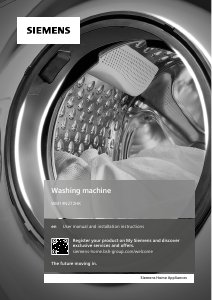
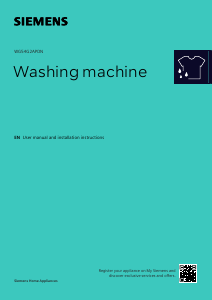
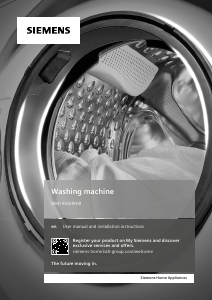

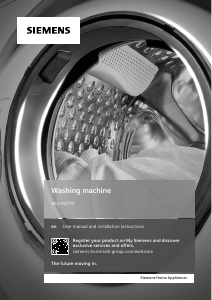
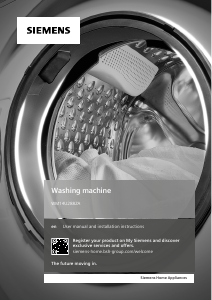
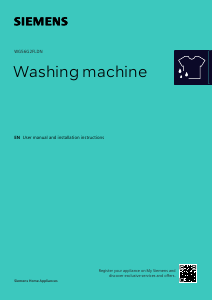
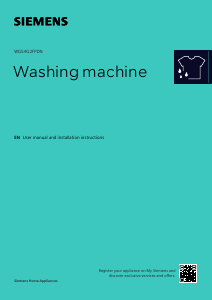
Join the conversation about this product
Here you can share what you think about the Siemens WT66B200BY Washing Machine. If you have a question, first carefully read the manual. Requesting a manual can be done by using our contact form.